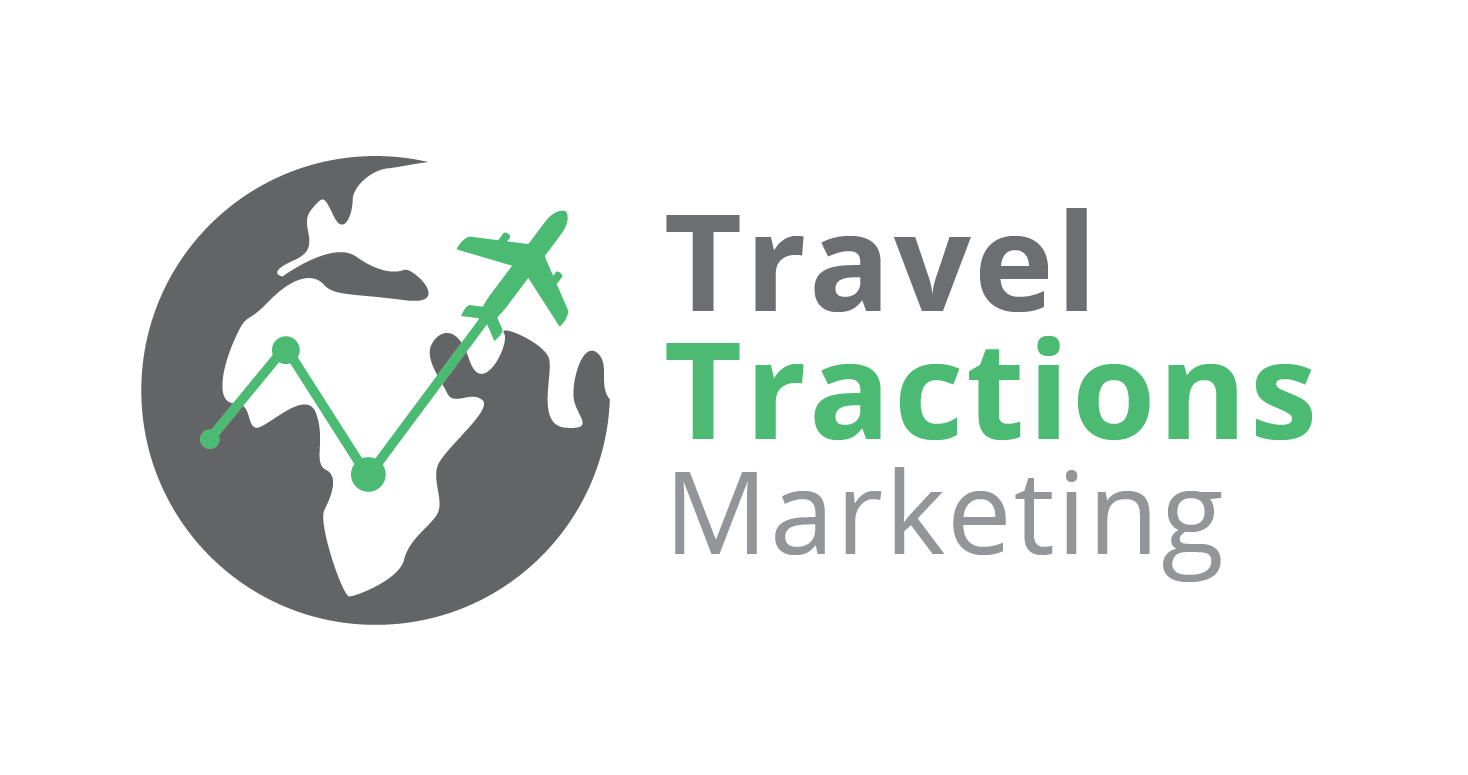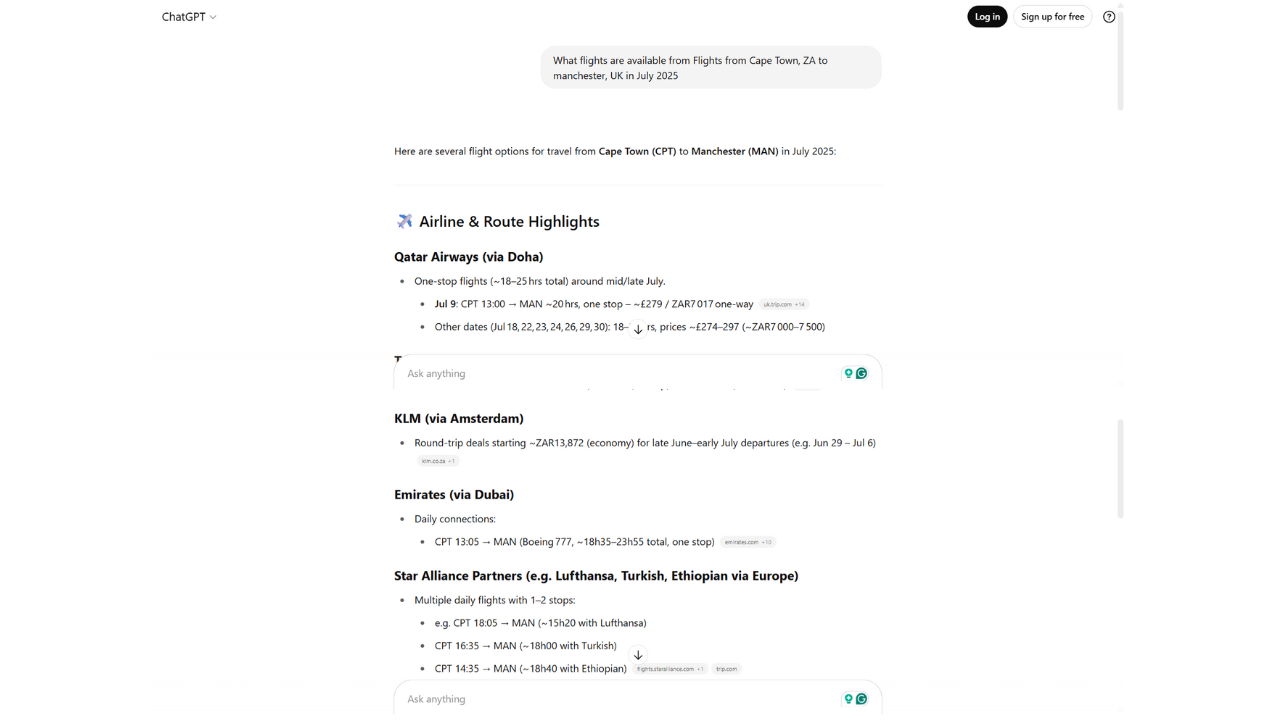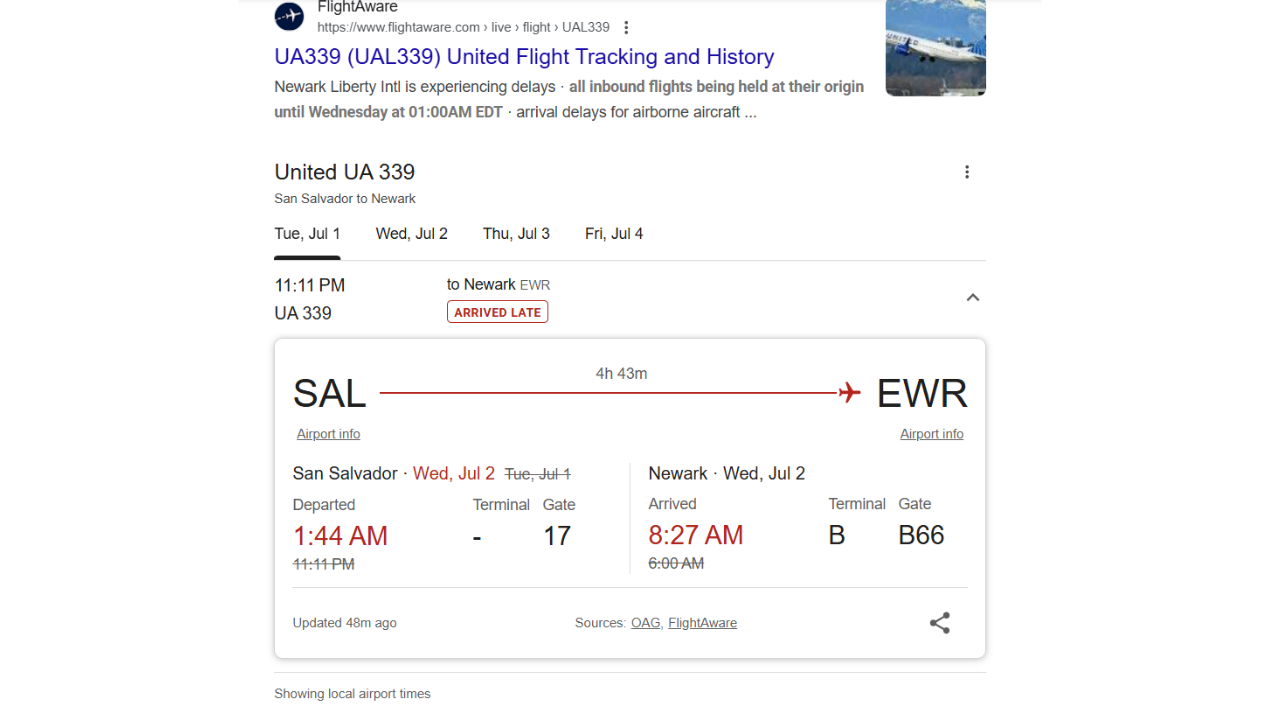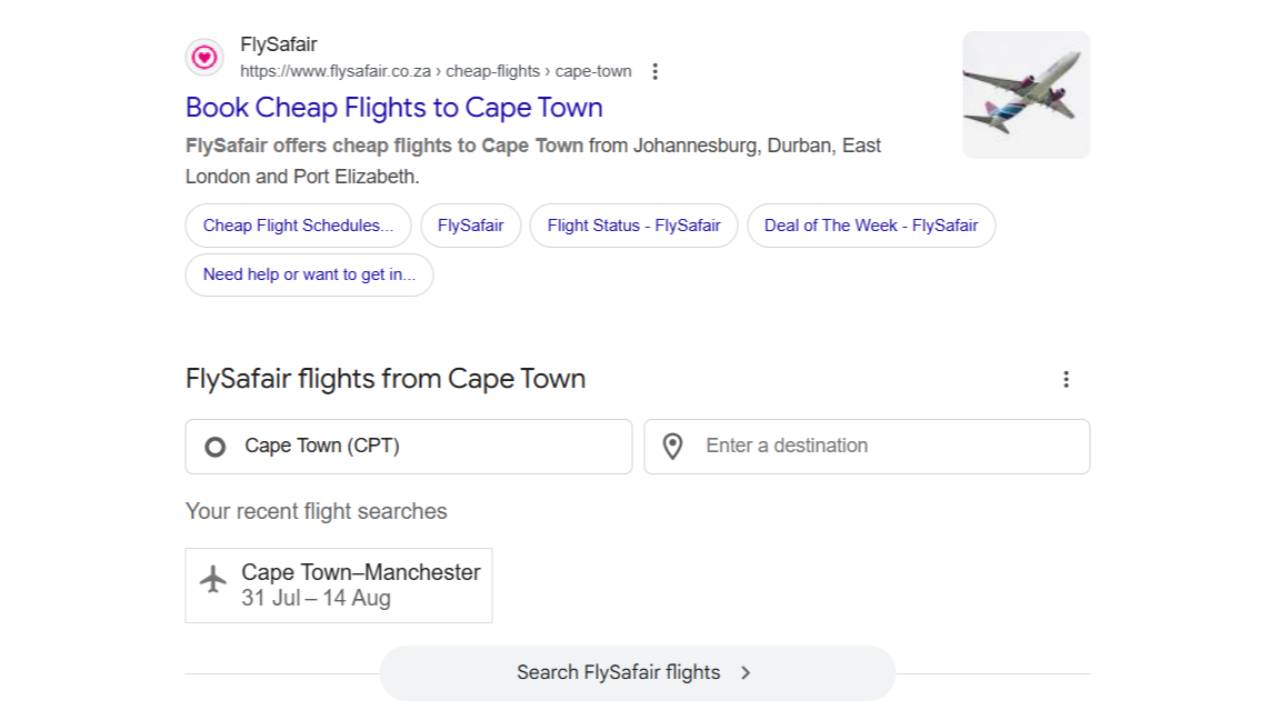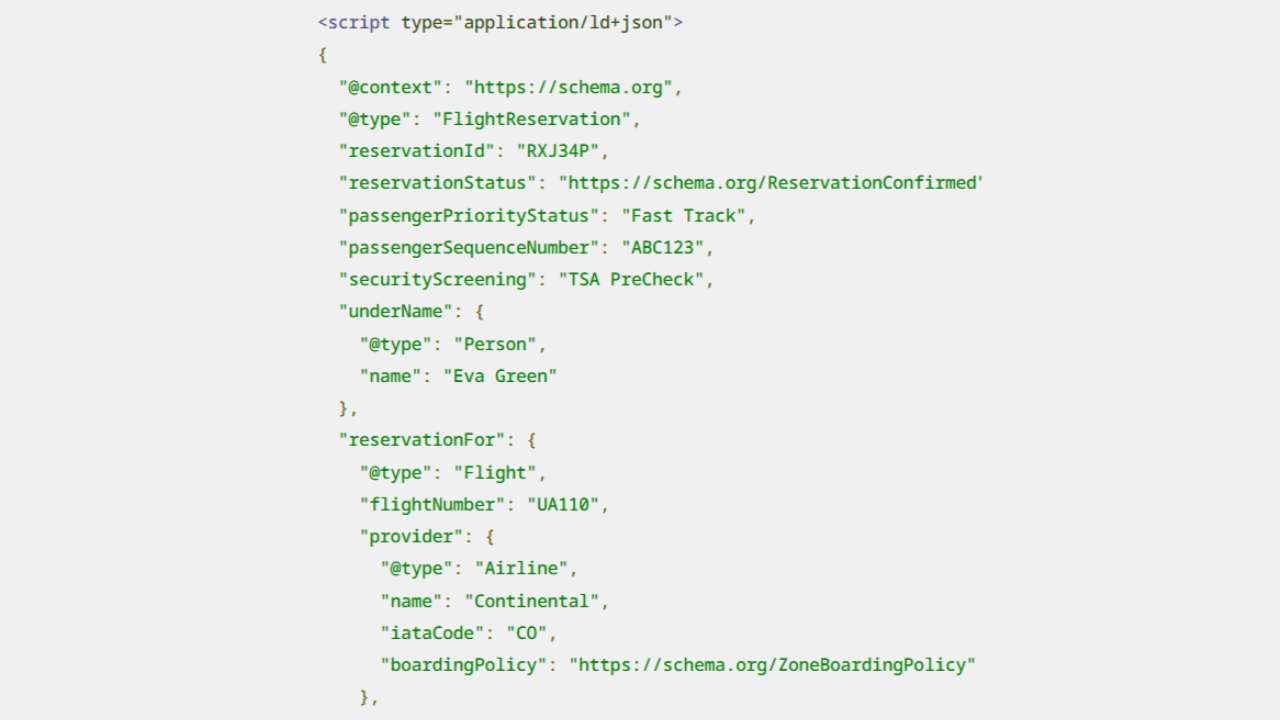

How to Optimise Your Airline or Booking Site With Flight Schema
Flight schema is a powerful set of tags that formalises how airline and flight information is presented online through search engines and AI systems. You may have seen it yourself when searching for flights online.
It’s the detail-rich search appearance that shows the current status of flights, including departure and arrival times, as well as flight costs. For airlines, travel platforms, and OTAs, this means you can capture a traveller’s attention quickly, reach higher click-through rates (CTRs), and directly achieve AI-readiness.
But how is it implemented, what are its benefits, and what are the best practices? Find out in this helpful guide that answers all of your questions.
What is Flight Schema?
Flight schema is the ideal way to present information in the most readable way for search engines and humans. This HTML code may seem complicated at first, but once broken down, it is pretty simple to understand.
It is typically implemented using JSON-LD, Microdata, or RDFa. It is placed directly in the webpage’s source, so search engines and travel platforms can read it. What’s the difference between the three ways of implementing schema? Here’s a quick breakdown:
- JSON-LD (JavaScript Object Notation for Linked Data) — The preferred and most used for schema markup. This is a block of code that gets added in the <script> tag and is invisible to site visitors.
- Microdata— Adds machine-readable labels directly to your visible webpage content using special HTML attributes, helping search engines identify and use information like names, addresses, or prices tied to the text users see on the page.
- RDFa (Resource Description Framework in Attributes) — Add in-line HTML or XML RDFa-specific attributes like about, property, and typeof, inside HTML elements to web content. These are mostly used in academic or government sites.
Schema Markup Types for Flights and Airlines
Several flight schema types organise the essential flight details. These are the most used properties added:
- flightNumber: This displays the unique airline IATA code and flight number, making it easier for you and search engines to identify.
- departureAirport: This indicates your flight’s departure terminal and the destination you’ll land in.
- arrivalAirport: This indicates the airport where the flight’s arrival terminal is and where you will land.
- departureTime: This displays the departure date and time of flights.
- arrivalTime: This displays the arrival date and time of flights.
- estimatedFlightDuration: This feature displays the estimated time required for a flight, allowing passengers to plan their day more effectively.
- flightDistance: See the distance the plane will travel, helping passengers understand the trip length.
- aircraft: This displays the type of aircraft this flight will be using. This is helpful to show as it can affect traveller comfort and services.
- boardingPolicy: How boarding is organised, so passengers know when and how to get on the plane.
- mealService: Whether food is served, which travellers want to know beforehand.
- Offer: This simply indicates an offer to provide a service, sell a product, or promote a giveaway.
Dynamic vs. Static Scheme Markup
| Dynamic Markup | Static Markup |
| Dynamic markups are best suited for airports and booking sites that want to provide their travellers with real-time updates on flights.
These also work well for websites with a lot of information that would take up too much time to input manually each day. |
Static markup is hardcoded JSON-LD that displays fixed details that rarely need to be changed. These are typically scheduled routes and promotions.
These require manual updates, so they may not be suitable for websites that require regular changes. |
AI Search Integration
With the rapid integration of AI programs (Google’s Search Generative Experience, Microsoft Copilot, Deepseek, ChatGPT, etc.), there is an increasing number of people relying on AI for quick answers. So, it’s good practice to optimise your content to appear in AI overviews as well.
By adding a flight schema, you make it easier for AI systems to read and pull your data from the web. This helps your site gain organic traffic and impressions from potential and recurring passengers.
(Flight details according to ChatGPT)
Examples of Real Use Cases
Several airlines use flight schema to display their airline details to gain the upper hand over the competition. Here are a few:
United Airlines
Passengers can quickly look up the real-time status of United flights without needing to open the website directly. This allows Google and other services to display rich flight details directly in search results or email previews, improving user engagement and clarity.
(Example of United Airlines’ flight details on Google)
FlySafair
FlySafair allows passengers to easily view available flights directly in search. It also highlights useful pages that people may find helpful when searching for flights.
(Example of FlySafair flight details on Google)
Benefits of Using Flight Schema
If you have a flight website or are an OTA, there are a few benefits from using flight schema to organise and display your air travel details on the SERPs.
Appear in Google’s Rich Results
By ensuring you have clear, machine-readable data on your website, your website can rank on the SERPs and display rich snippets. These are especially helpful if your goal is to drive direct bookings and increase organic traffic, as they help you stand out from the competition by displaying pricing, flight times, airlines, and more in the SERPs.
AI Overviews
By focusing on optimising your content for AI-driven search, Answer Engine Optimisation (AEO), and even voice search, you can ensure that your data is easily understood, read, and pulled into AI systems. This benefits your business by leveraging emerging tools to ensure you are future-proof.
Help Search Engines Understand Flight Availability, Pricing, Routes, and Schedules
Flight schema provides Google with a comprehensive overview of airline flights and their details, from IATA code to the flight’s departure gate. This rich data is easier for search engines to read and for humans to scan for answers.
Easier User Experience
Rich snippets enable your audience to access key information and find what they’re looking for with greater ease. This also helps reduce bounce rate as they can already see what they’re looking for. Once they click on the page link, they are already certain this is the page they’re looking for.
Improve Trust
Through enhanced listings, you can gain a competitive edge by presenting a more professional, informative, and visually appealing image to potential passengers.
How to Implement Flight Schema: An Easy Step-by-Step Guide
To add these unique identifiers to your flight data, you’ll need to embed the structured data in your website’s HTML using JSON-LD. Here’s a step-by-step overview:
Step 1: Gather Flight Details
Collect all key details that your audience might want to know about their flights. These include arrival times, flight’s arrival gate, IATA code, security screenings, and boarding policies.
Step 2: Generate JSON-LD Code
Use flight schema generator tools, like Schemantra, to help you write your unique JSON-LD script. This code should include properties such as ‘flightNumber’ and ‘departureAirport’ as found on Schema.org.
(Example of Flight Information Schema in the JSON-LD format as per schema.org)
Step 3: Embed the Code on Your Webpage
To embed your generated JSON-LD code on your site, you need to add it to the HTML section. Simply paste it within the <head> or <body> section where the flight information is presented, and it should display.
Step 4: Validate Your Markup
Tools like Google’s Rich Results Test and the Schema Markup Validator were designed to help you check your JSON-LD code. It points out errors and warnings to confirm whether it qualifies for rich results in search engines.
Step 5: Monitor and Update Your Markup
It’s essential that data continues to work smoothly and displays the correct information at all times. This ensures that passengers receive accurate information before purchasing tickets or boarding flights.
Best Practices and Common Mistakes
- Do keep your data accurate and synced, like when a flight terminates or boards. If you have fixed times and static markups, they will be sufficient.
- Don’t have mismatches between structured data and visible content. This causes confusion among passengers and search engines, which in turn lowers your trust.
- Do use plugins or tools like Yoast SEO, RankMath, or Schemantra to help you generate and manage the needed code.
- Don’t markup unavailable flights, placeholder data, or an outdated boarding policy. This causes confusion and lowers trust and authority.
FAQs About Adding Schema Markup to Airline Flights
Do you still have a few questions about schema markups for flights? We have answers.
Which Flight Schema Generator is the Best to Use?
The easiest flight schema generator to use is Google’s Structured Data Markup Helper or Schemantra. Both systems support a wide range of schema types and are available for free use.
Are Flight Schedules Structured Data?
Yes, flight schedules are considered structured data. This is because they follow a defined format that is easily scannable and filled with helpful content relating to air travel.
How Can I Check if My Markup is Correct?
Tools like Google’s Rich Results Test and the Schema Markup Validator allow you to validate your code. They point out possible errors and warnings that could possibly interfere with your code not displaying correctly.
Does Adding Flight Schema Improve SEO?
Yes, a properly implemented flight schema can enhance your search listings with rich snippets, making flight details more visible and attractive to users. This, in turn, can increase click-through rates.
Wrapping Up Flight Schema for Airline or Booking Site
Having valuable information, such as the origin of your flight, arrival times, and reservation reports, upfront can push a customer who’s on the fence to become a paying one. Using flight schemas gives your airline or booking site a rich snippet in the SERPs and AI-driven tools, increasing user engagement and CTRs.
These enhancements significantly enhance SEO performance and deliver a seamless user experience, which can help you build brand loyalty and attract returning customers.
